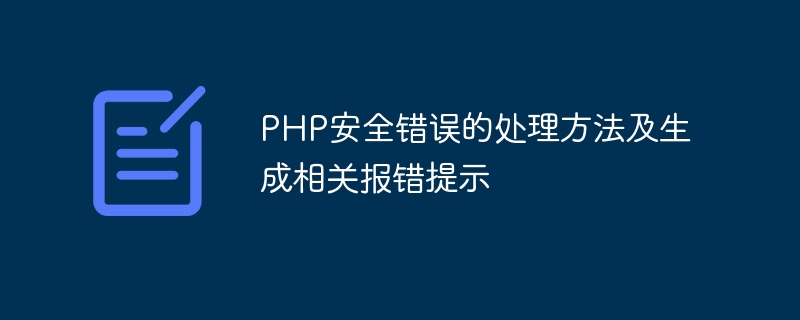Home >Backend Development >PHP Tutorial >How to handle PHP security errors and generate related error prompts
How to handle PHP security errors and generate related error prompts
- PHPzOriginal
- 2023-08-07 19:31:451475browse

How to handle PHP security errors and generate related error prompts
As a commonly used server-side scripting language for development, PHP is widely used in the development and application of Internet technology middle. However, due to the flexibility and ease of use of PHP, it also brings some security risks to developers. This article will discuss how to handle PHP security errors and how to generate relevant error prompts.
1. Filter user input data
In actual development, user input data is the most likely place to cause security problems, such as SQL injection, cross-site scripting attacks, etc. In order to avoid such problems, we can ensure security by filtering and validating user input data.
- Prevention of SQL Injection
SQL injection may be the most common attack method. It injects malicious SQL code into user input to maliciously operate the database. the goal of. To avoid SQL injection, we can use the mysqli_real_escape_string() function in PHP to filter user-entered data.
// 连接数据库
$conn = mysqli_connect("localhost", "root", "password", "dbname");
// 过滤用户输入
$username = mysqli_real_escape_string($conn, $_POST['username']);
$password = mysqli_real_escape_string($conn, $_POST['password']);
// 执行SQL查询语句
$sql = "SELECT * FROM users WHERE username='$username' AND password='$password'";
$result = mysqli_query($conn, $sql);- Prevent cross-site scripting attacks
Cross-site scripting attacks (XSS) refer to attackers injecting malicious scripts into web pages to obtain sensitive user information or execute Other malicious operations. In order to prevent XSS attacks, we can use the htmlspecialchars() function in PHP to filter user-entered data.
// 过滤用户输入 $username = htmlspecialchars($_POST['username']); $password = htmlspecialchars($_POST['password']);
2. Enable error reporting and logging
PHP provides a variety of ways to generate error reports and logging to better understand and handle potential security errors.
- Error reporting settings
In the PHP development environment, we can enable error reporting by modifying the php.ini file. Find the following code and modify it to:
error_reporting = E_ALL display_errors = On
This will display all error messages, including fatal errors, warnings and prompts.
In a production environment, in order to ensure security and reduce unnecessary risks, we can set the error report to:
error_reporting = E_ALL & ~E_DEPRECATED & ~E_NOTICE display_errors = Off
This will only display fatal errors and output the errors to the log in the file.
- Error logging
In order to better track and handle errors, we can record PHP error logs to files. Modify the php.ini file:
log_errors = On error_log = /path/to/error.log
In this way, the PHP error log will be recorded in the file with the specified path.
3. Exception handling
Exception handling is a more flexible and advanced error handling mechanism that handles errors by throwing exceptions and catching exceptions. By using try-catch blocks, we can control and handle potential security errors more precisely.
try {
// 一些可能引发异常的代码
} catch (Exception $e) {
// 异常处理代码
}Exception handling allows us to better control errors, avoid exposing sensitive information to attackers, and take corresponding security measures or output more friendly error prompts to users.
To sum up, it is very important to deal with PHP security errors and generate relevant error prompts. By filtering user input, enabling error reporting and logging, and exception handling, we can maximize the security of our development and better respond to potential security risks.
The above is the detailed content of How to handle PHP security errors and generate related error prompts. For more information, please follow other related articles on the PHP Chinese website!

